São Jorge is the fourth largest island of the Azores by land area, and one of the prettiest. São Jorge is a paradise for a traveler who loves peace and wants to experience unique nature adventures, amazing sceneries and local village life. There are several hiking trails leading up and down the steep coastal cliffs, lush forests and sympathetic hamlets of the island.
The shores of São Jorge feature unbelievably beautiful vistas over the glimmering deep blue sea and the volcano of Pico on the opposite island shore. Between hikes, one can dive into the crystalline natural pools and waterfalls as well as enjoy the delicious cheese of São Jorge, paired with freshly bakes bread, local seafood and wine produced in the Azores.
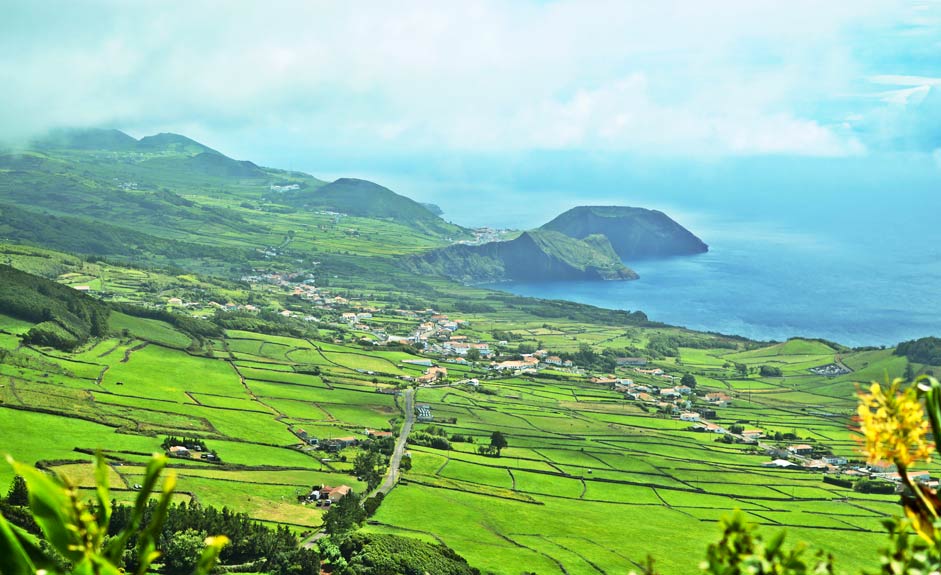
The island of São Jorge is 54 kilometer long and only 6 to 8 kilometers wide, which is why it has been given the nickname Dragon, thanks to its lengthy and mountainous shape. The middle section of São Jorge consists mainly of mountain ridges, surrounded by rolling pastures, forest patches and hydrangea bushes.
There are wonderful views everywhere on the island, because São Jorge is lined by up to 400 meters high coastal cliffs, under which there are flat cape-like areas, debris fields formed either by lava flows or landslides. These are called “fajã” and there are over 60 of them on the island. Most of the coastal villages of São Jorge are located on such fajãs under steep slopes.
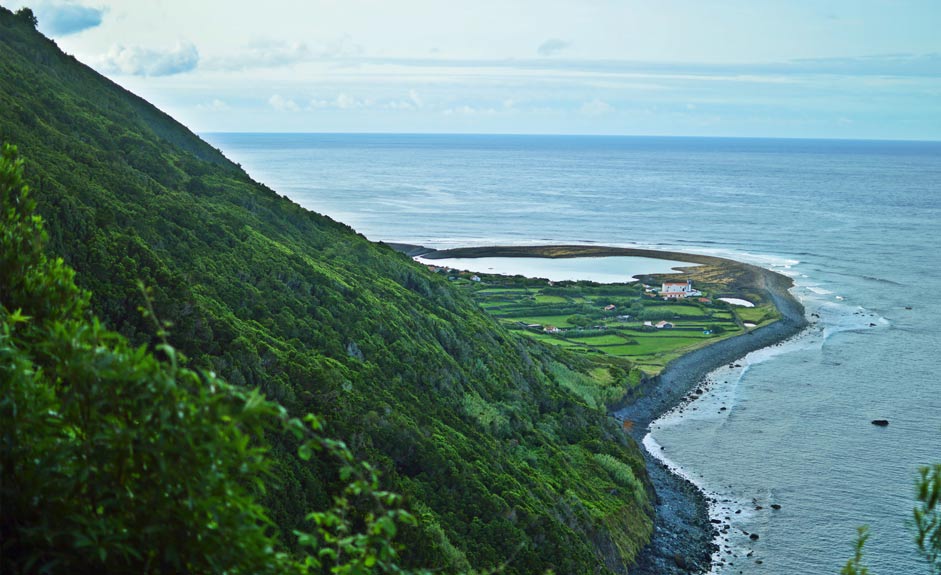
The time needed for a holiday on São Jorge varies from a couple of days up to a week. A week is enough to see the majority of the sights, but it doesn’t hurt to stay even longer in order to explore the island more thoroughly.
Accommodation with sea views in São Jorge
São Jorge is among the less visited Azorean islands, even though the sceneries are second to none. Because of the low tourist numbers and the population of only 9000 inhabitants, there is not a huge selection of restaurants, hotels or tour operators, but an unforgettable island holiday will nevertheless succeed smoothly by planning ahead a little.
If staying close to dinner restaurants is desirable, the capital town Velas located on the western part of the island is a good choice. There are a handful of hotels, restaurants and cafés in the town. Also the airport and the main port of São Jorge are located in Velas. The other of the two ferry ports is located in the middle part of the island, in the village of Calheta. The village has a more rural vibe and only a few accommodations.
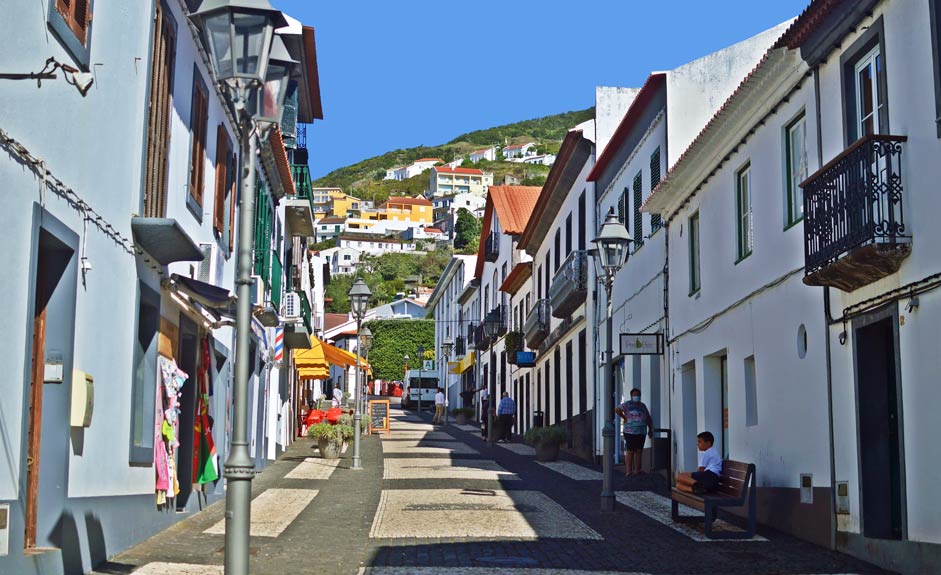
The range of accommodation on São Jorge includes conventional hotels, beautiful camping grounds and lovely traditional holiday houses. There are also a few special places to stay at, for example bungalows equipped with sea views, glamping yurts as well as eco resorts. More than one of these extraordinary accommodations are located in Urzelina, a little east of Velas. The area is a good choice not only because of its peaceful yet central location, but it also has good road connections both to the restaurants of Velas and elsewhere on the island.

Camping grounds equipped with amenities can be found in Velas, Calheta and Urzelina.
The unbelievable sceneries, picturesque villages and natural peace of São Jorge
Fajã da Caldeira de Santo Cristo
São Jorge is known for its fajãs, and Fajã da Caldeira de Santo Cristo on the northern side of the island is the most famous of them. This remote coastal village can only be accessed by foot or an ATV, and electricity has been installed there only recently. Back in the days, the generator of the village was turned on once per week in order to play the Sunday mass from the church’s radio.
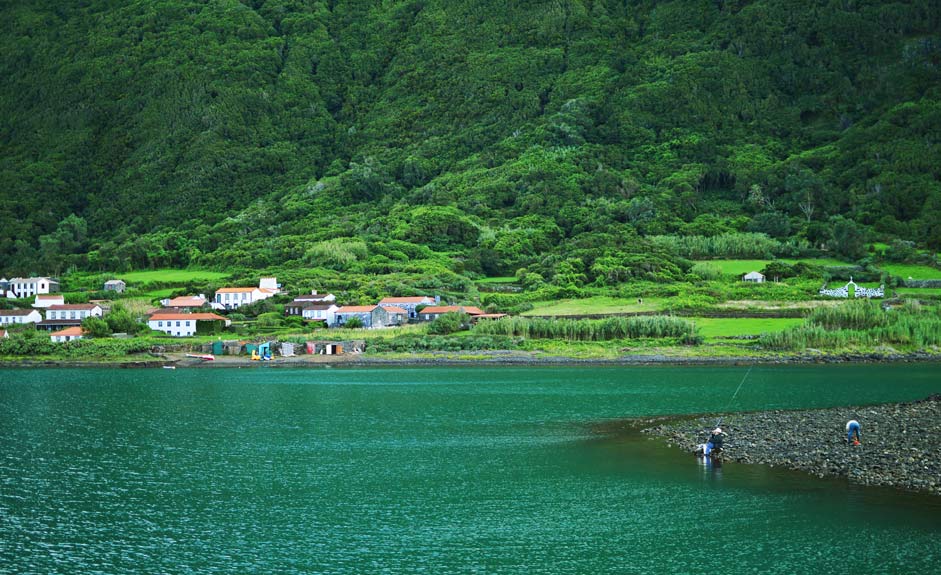
The highlights of Fajã da Caldeira de Santo Cristo include its deep turquoise lagoon and the clams farmed in its waters, as well as the world-class surf waves that have made the place popular among surfers. It’s best to get to know this tranquil village slowly by foot. The rock bottom lagoon is also adequate for swimming.
There is a dirt path leading to the village from Fajã dos Cubres that can be navigated by foot or by an ATV. The journey takes around one hour when walking and there are waterfalls crossing the road on rainy days. Another option is a longer hiking trail that starts on top of the Serra do Topo mountains. The trail is a 10 kilometer long well marked path that is mostly downhill and goes through several fajãs. The trail first descends in a green valley, diving into a mystical forest later on. In the midst of the trees, there is a hidden waterfall with a pond that is perfect for taking a cooling dip.
Fajã dos Cubres
Fajã dos Cubres is the next fajã following Fajã de Caldeira de Santo Cristo on its northwestern side. Hence, it is recommendable to visit both villages in one go. Fajã dos Cubres is accessible by car through a steep but well-maintained switchback road. Before descending into the village, there are breathtaking viewpoints with sceneries not only over Fajã dos Cubres but also over Fajã da Caldeira de Santo Cristo.
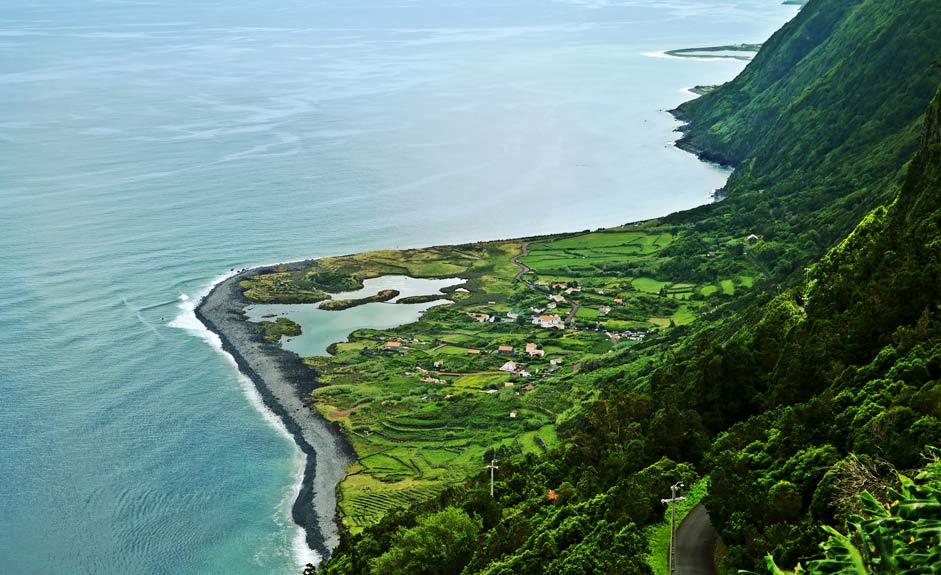
Fajã dos Cubres boasts a lagoon too, but it’s more of a wetland zone in its natural state and not adequate for swimming. In the middle of the lagoon there is a traditional round stone building, connected by a narrow swath, from where the beauty of the village can be best admired.
Fajã do Ouvidor
Fajã do Ouvidor is among the largest fajãs of São Jorge and also known as Fajã do Porto, thanks to harboring the largest port of the northern side of the island. The natural pool of Poça Simão Dias is what makes this fajã truly special, but there is also another, smaller sea water pool at the port area of Fajã do Ouvidor. The port is surrounded by gorgeous coastal sceneries and there is also a restaurant serving the delicious clams of Caldeira de Santo Cristo.
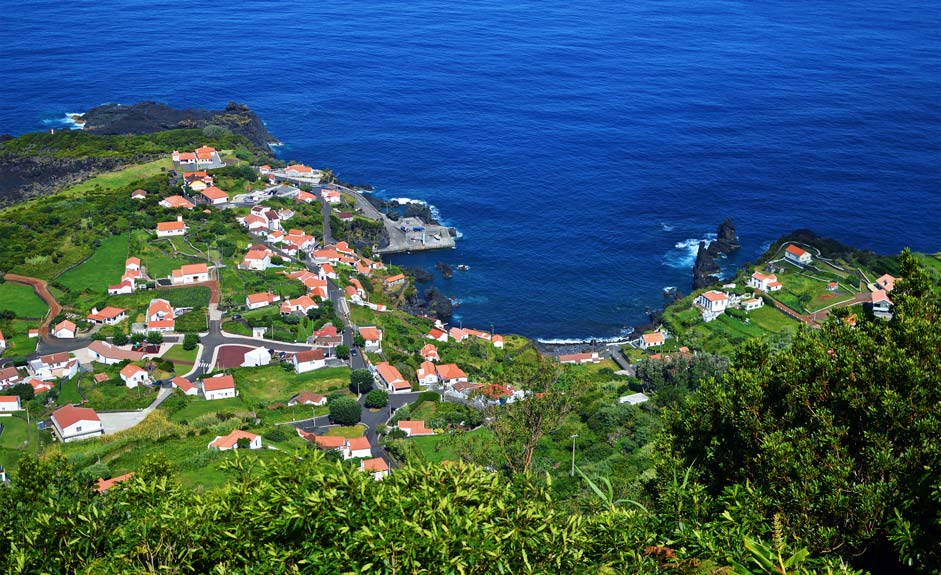
The views over Fajã do Ouvidor and the neighboring fajãs can be witnessed from the viewpoint located close to the port. Another viewpoint, called Miradouro da Fajã do Ouvidor, can be found higher up, before the road that leads down into the village. From there one gets a good overview of Fajã do Ouvidor and some great panoramas, too.
Norte Pequeno
Norte Pequeno is a village and a hiking trail located on the northern side of São Jorge, along which one can get to know three different fajãs, called Fajã do Mero, Fajã da Penedia and Fajã das Pontas. The hike of approximately three hours and 10.8 kilometers is classified as intermediate, first descending through a steep forested trail down to the coast, winding through the fajãs and finally climbing back up on a dirt switchback road.
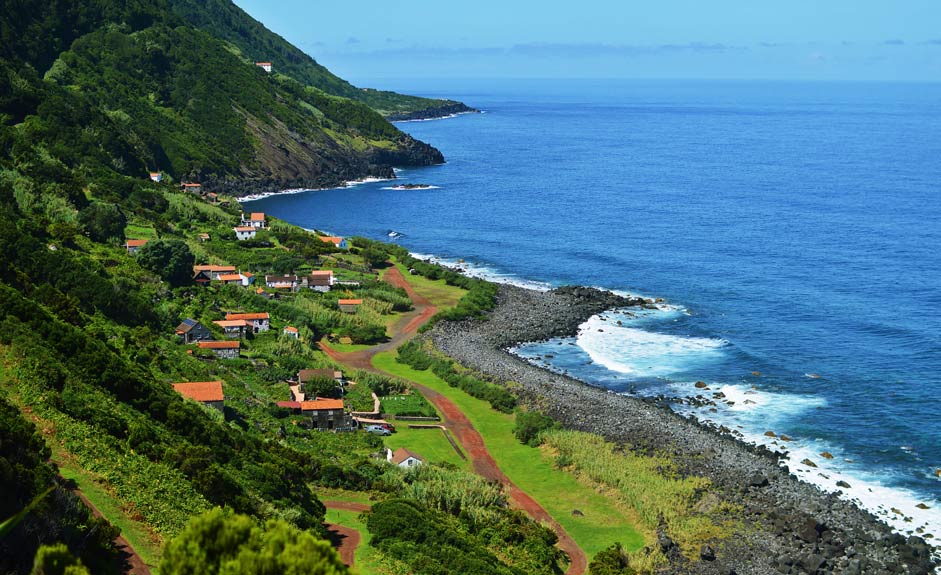
On the way, one gets to witness some of the most incredible sceneries over the coast of São Jorge, life in remote hamlets and the lush vegetation ranging from the endemic Azorean flora to exotic species and fruit trees. In Fajã da Penedia it’s worth checking out the Chapel of Santa Filomena, and in Fajã das Pontas there is a small fishing dock with a natural pool area, revitalizing tired hikers along the way.
Fajã de Além
Fajã d’Além is a village of some 20 houses, located on a coastal fajã that can be accessed only by hiking three hours on a difficult and steep trail. The hamlet is so remote that some of the household supplies are lowered down on a cable lift. However, the volcanic rock houses and the amazing views from the path make the hike worth the hassle.
Fajã dos Vimes
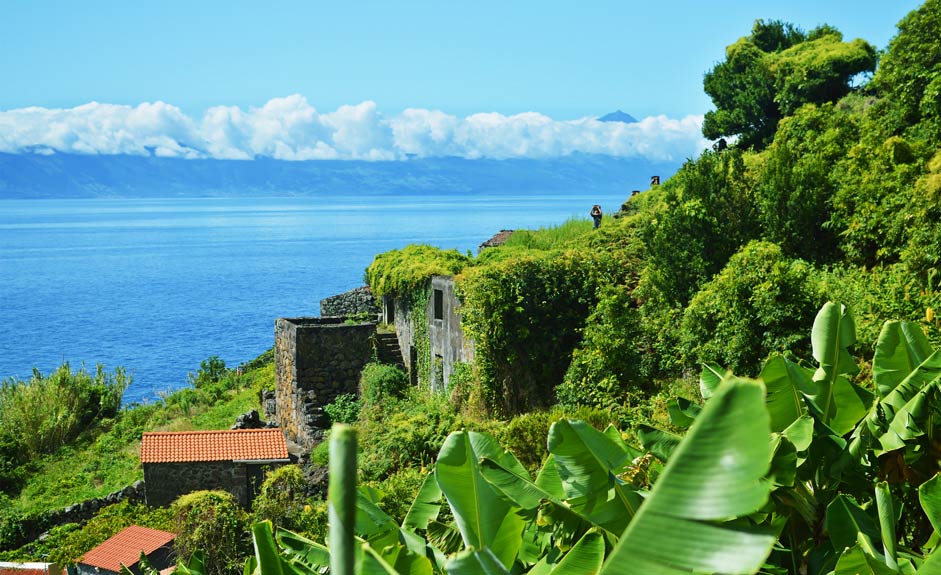
São Jorge is home to the only coffee plantations in Europe, located in Fajã dos Vimes on the southern coast of the island. The coffee plants are growing on the backyard of Café Nunes, made possible by the favorable microclimate and taken care of by the owner of the coffee shop. The soft and fruity coffee brewed from the coffee beans can be tasted in the café, accompanied by home-made local pastries. Tours on the small coffee plantation are also available.
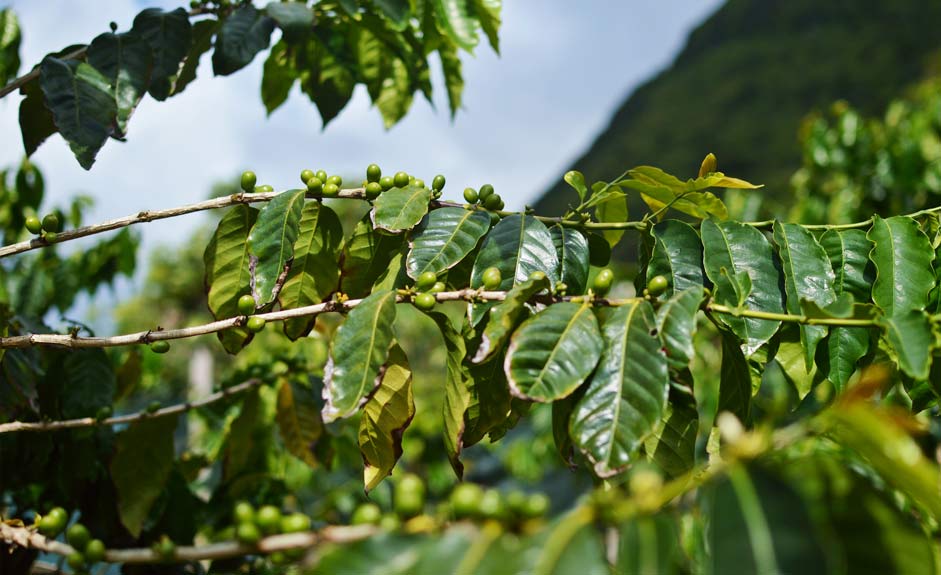
In the Fajã dos Vimes village one can also see and buy the traditional woven ponto alto bedspreads and other crafts, still handcrafted by the local women. There is also an easy hiking trail, following the coast in the forest up to an old wineyard, continuing upwards through ancient stone stairs. The trail is linear, so it’s mandatory to either come back through the same route or take a taxi back to the car from the main road.
Fajã de São João
Located in the eastern part of the island, Fajã de São João is perhaps the most beautiful and picturesque of all the villages of São Jorge. In this sympathetic village, most houses are built traditionally from volcanic rocks and many are surrounded by pretty little gardens. The atmosphere on the main road of the village is laidback, even sleepy, and there are many doors that open up to the domestic wine cellars of the traditional homes.
The dock of Fajã de São João is a popular swimming spot in the summer, and there is a café next to it. The village is accessible by car through a steep and narrow switchback road, often allowing only for the width of one car. There are limited parking spots next to the dock.
Fajã das Almas
Fajã das Almas is one of the fajãs located on the southern side of São Jorge. Some of the houses have been built boldly in a row around the boulders that fell from the cliffs above. The highlight of Fajã das Almas are the lovely natural sea water pools. The place is located in a natural protection area, so many sea birds can be seen in the environment.
Fajã das Almas has several houses and two hermitages with chapels, after which the village has been named. Nowadays there are only five permanent residents in the village, but there are nevertheless a couple of restaurant-cafés with sea views. There is a parking lot a bit before the village where one can leave the car and continue the rest of the way to the village by foot.
Velas
The capital of São Jorge is located on the western side of the island and called Velas. The beautiful old town spreads between the steep mountain cliffs and the ocean. There is a gate called Portão do Mar, formerly a part of the city wall, which has been welcoming the guests arriving from the seas into the town since 1799. Doing a little walking tour in the town center of Velas is highly recommended, in order to get to know the streets, colorful facades and the peaceful atmosphere of the oldest town of São Jorge.
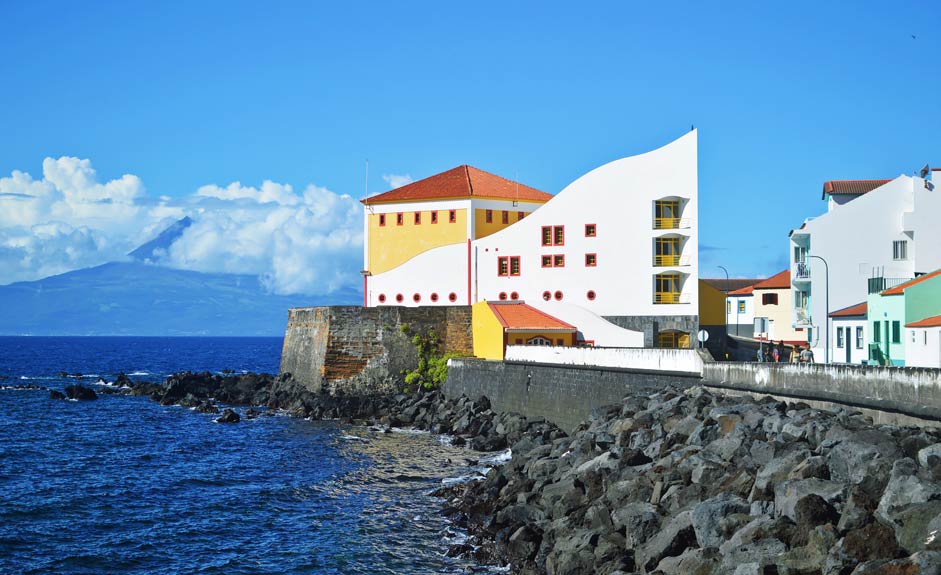
The white and yellow auditorium that has been built in the old sea fortress of Forte de Nossa Senhora da Conceição das Velas is a sight in its own right, as is the black and white church Igreja Matriz de São Jorge. It also includes the Museu de Arte Sacra exhibiting Catholic art. The colorful central garden of Velas, Jardim da Praça da República, is an inviting oasis where to do some people watching on the red benches, or grab a coffee at the café next to the park.

Ponta de Rosais
São Jorge is a long island, whose western end is called Ponta de Rosais. It can be found at the end of a long and straight dirt road that continues for kilometers through the forest patches and rolling cow pastures. At the end there is an abandoned lighthouse and a whalers’ watchtower, from where the movements of whales were observed before taking on to the sea. The natural monument of Ponta de Rosais has incredible views to the ocean and the surrounding Azorean islands.
There are many viewpoints in the Rosais area that deserve a stop, such as Miradouro do Pico da Velha. The magical forest park called Parque Florestal das Sete Fontes, on the other hand, is a great place for having a picnic break. The park is named after seven fountains.
Urzelina
The village of Urzelina is known for its traditional red and white windmills, dotting its rocky shores. There is a paved coastal road offering an easy walk to admire the windmills. In Urzelina there is also a church tower that survived from the volcanic eruption of 1808 by a miracle. Nowadays the lonely tower peeks amongst the black volcanic rocks, already overgrown with vegetation, as a symbol of the Azorean perseverance.
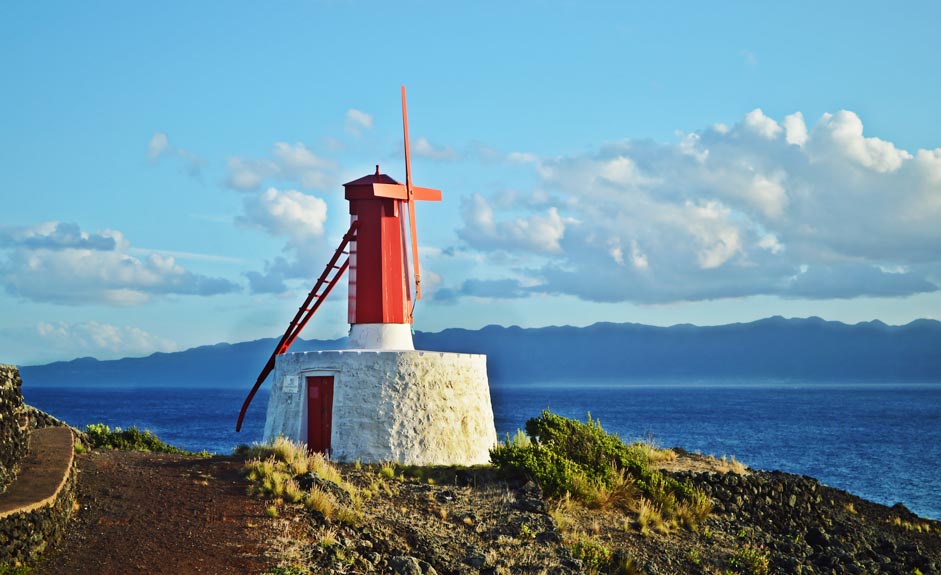
The Gruta Furna das Pombas cave is situated close to the port of Urzelina and has formed as a result of a volcanic eruption as well. The cave can be explored by boat when the ocean is calm. On the other side of the port cove there is a public pool called Piscina da Urzelina.
In the gorgeous coastal views of Manadas, located east from Urzelina, lies the beautiful baroque church of Igreja de Santa Bárbara. It’s worth taking a peek inside in order to see the gold-plated altar and the cedar wood ceiling.
Calheta
The second largest town of São Jorge, Calheta, is more country-like, sleepy village with a port, located on the Fajã Grande. The sights of Calheta include the old factory Santa Catarina Indústria Conserveira producing canned tuna, from where it’s also possible to buy the products and take them back home. Another curiosity is the ethnographic museum Museu Francisco Lacerda, whose permanent exhibition showcases the history and traditional lifestyle of São Jorge.

The ferries to other Azorean island depart from the docks of Calheta, but it’s also home to some local fishing boats and tour operators. The port also doubles as a bathing zone, nice for spending a relaxing beach day.
Topo
Along the road that leads to the eastern end of São Jorge, there are several viewpoints from which to admire the rugged mountain sceneries around the volcanic complex of Topo. The viewpoints make great picnic spots, too.
The village of Topo lies at the eastern end of the island, with its centuries-old houses and churches waiting to be explored. From the coast of the cape, a view opens up over the islet of Ponta do Topo – a pasture where cows swim during summertime – and the island of Terceira looming behind it. There is a seawater pool, a playground and a free camping zone next to the boat harbor, where one can pitch a tent or have a nice barbeque picnic. There are also a couple of cafeterias and restaurants in the Topo village.
Pico da Esperança
Pico da Esperança is the highest point of São Jorge Island at an altitude of 1053 meters. From the peak, there are gorgeous 360 degree views over the neighboring islands as well as the over 200 cone-shaped volcanic craters and multiple small lakes dotting the Cordilheira Central mountain chain. The dirt road leading to the base of the peak is narrow, but drivable with a normal car. The rest of the way up is by foot and takes around 10 minutes. It’s advisable to visit the mountains during clear weather, in order to actually see the views.

Activities
São Jorge has amazing opportunities what comes to practicing all kinds of water sports, from scuba diving to fishing, from snorkeling to sailing and from surfing to kayaking. Boat trips to explore the caves and shipwrecks surrounding the island are also available. There are also many extreme sports that can be tried out on land, ranging from mountain biking tours to cave expeditions, from jeep safaris to guided trekking and from rock climbing to canyoning. There are a handful of tour operators to choose from.
Whale watching tours are organized more frequently on the larger islands of the Azores, but if São Jorge is the only destination of the holiday, asking about whale watching with the local companies offering boat trips may be a good idea.
São Jorge features crystal clear sea water pools instead of sandy beaches
Long sandy stretches are conspicuous by their absence on São Jorge, but it doesn’t mean that the island couldn’t be a great beach holiday destination during summertime. The coast of the island is dotted with natural swimming pools formed by lava rocks, with crystal clear waters and often incredibly beautiful surroundings. Many bathing areas are also equipped with a stretch of concrete beach where one can comfortably spread their towel.
Poça Simão Dias
São Jorge is known for its natural swimming pools, and the most famous of them is Poça Simão Dias located on the Fajã do Ouvidor. The natural pool is located among a rocky landscape of wild cliffs and caves with bats flying between them even in the hot afternoon sun. The pool itself is large and crystalline, offering a perfect setting for snorkeling or just floating in the cool waters of the Atlantic.
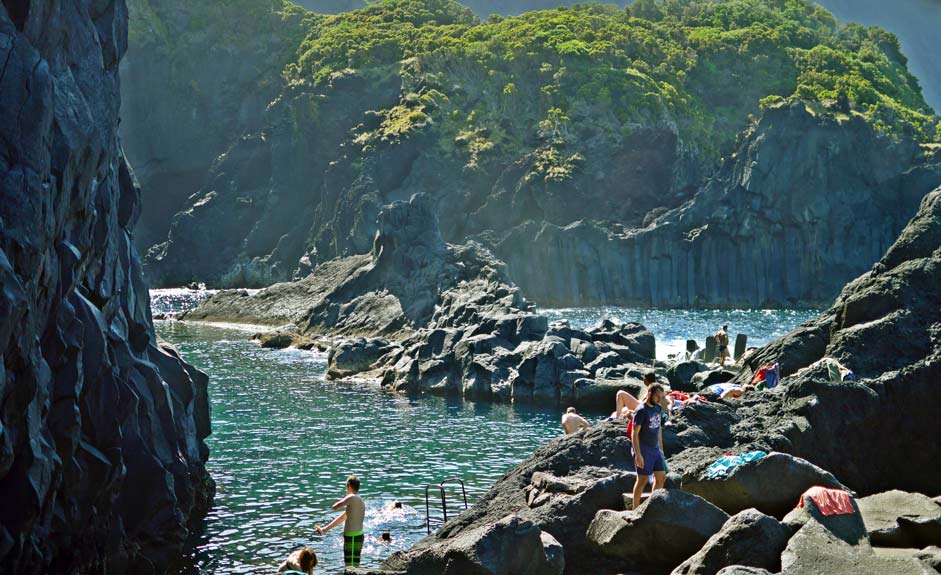
There is not much space for sunbathing on the beach, but between the rocks there may be a cranny just big enough to spread the towel. The port area has limited car parking spaces, from where it’s a short walk to Poça Simão Dias along a trail. There are no facilities at the bathing zone.
Piscina da Fajã do Ouvidor
The port of Fajã do Ouvidor has been built in a cove with breathtaking sceneries, and there is also a seawater pool for swimming. The place is surrounded by the steep green cliffs of São Jorge’s coast. The pool is adequate for families with kids. There is also a restaurant close by.
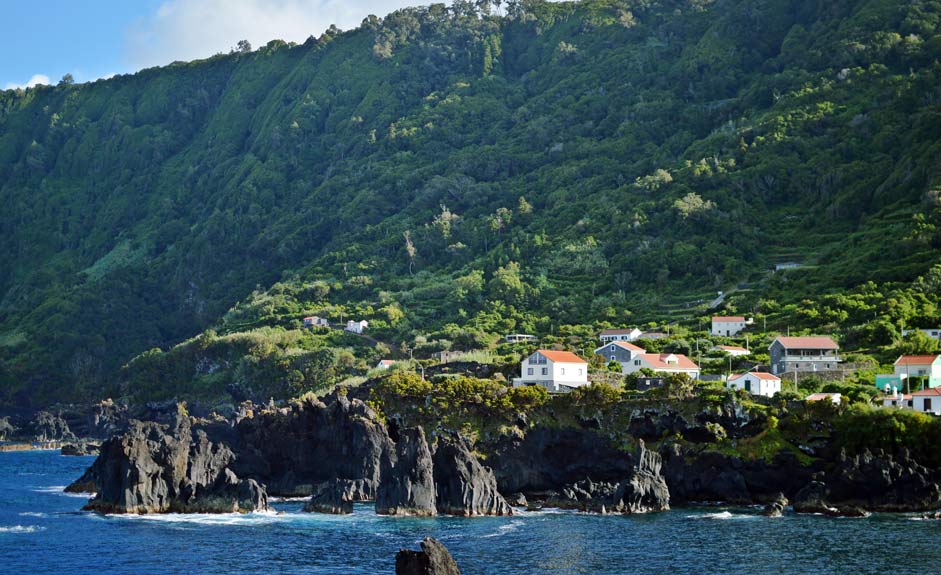
Piscinas Naturais da Preguiça
The natural pools of Preguiça lay a little west from Velas, surrounded by beautiful nature and gorgeous sceneries. Several shallow coves lined by basaltic rocks and the clear waters of the Atlantic make the spot excellent for swimming and snorkeling.
Poça dos Frades – Velas
If looking for a cooling dip in the center of Velas town, one can head to the Poça dos Frades bathing spot. There is a beach area made of concrete among the volcanic rocks, equipped with sunshades. The views towards the neighboring islands of Pico and Faial make the swimming experience unique. There are parking lots, restrooms and a beach bar at the bathing area.
Fajã das Almas
Fajã das Almas is home to gorgeous natural pools and a tranquil place to spend a beach day with the volcano of Pico looming on the opposite shore. There is a concrete beach structure for sunbathing and a couple of cafés and restaurants close to the bathing area. The pools are child-friendly.

Piscinas Naturais da Fajã Grande
Located in Calheta, the Fajã Grande has a beautiful set of natural swimming pools, offering cooling dips in the ocean or sunbathing on the concrete beach, among the lava rocks. The beach is guarded by a traditional windmill. The spot is perfect for sunset watching. There is also a camping ground with a café located right next to the natural pools.
Porto da Calheta
The turquoise green water and the thatched sunshades made with natural materials make the port of Calheta look like a paradise. The place is popular among swimmers and sunbathers alike. It’s also a good spot for snorkeling. There is a café next to the port.
Piscina Natural da Pontinha do Topo
The natural pools of Topo lay at the very easternmost end of São Jorge. The pools are located in a park-like area with views over the islet of Topo and Terceira Island. There are toilets, showers, a café-bar, playground, camping ground and a cooking area. The pool is adequate for families with kids.
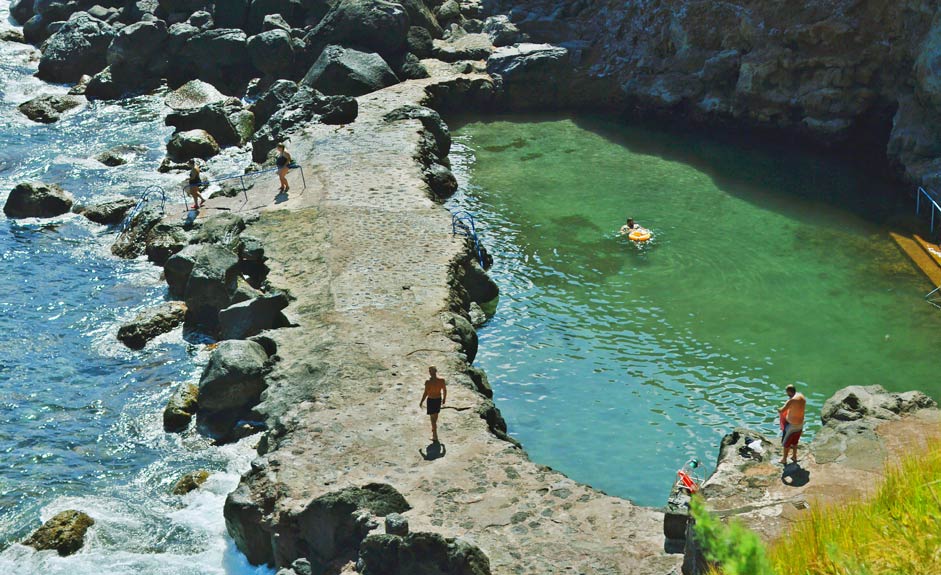
Fajã das Pontas
When looking for a quiet and secluded swimming spot, the natural pools of Fajã das Pontas are a must visit on the northern coast of São Jorge. There is a hamlet of a couple of houses situated below a steep switchback road, with a tiny port next to the natural pools. They are adequate for families with kids.
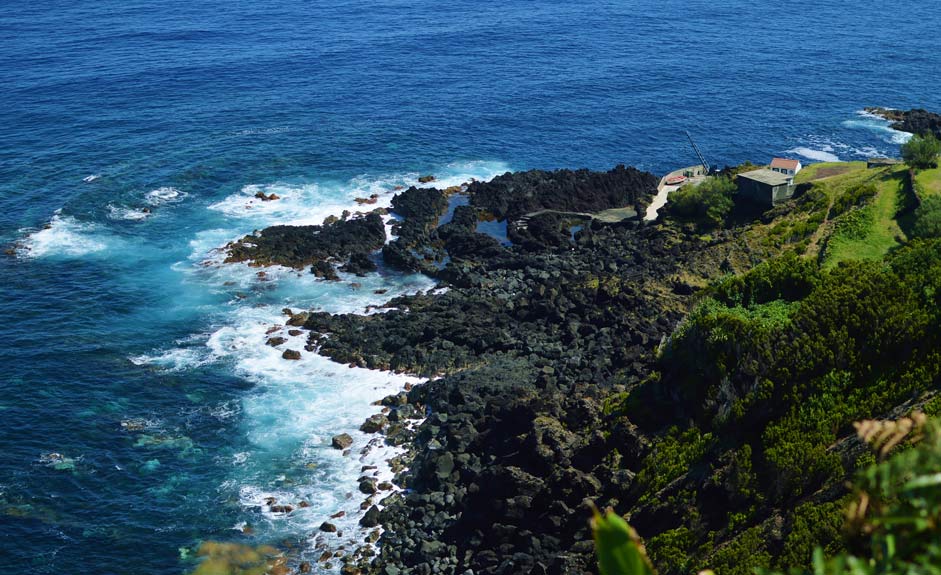
Local delicacies – São Jorge cheese and clams from the island
While on São Jorge, it’s advisable to plan the meals ahead, because there isn’t a large selection of restaurants on the island. Especially during the summer season the restaurants may be full, so booking ahead is strongly recommended. The kitchen usually close around 9 pm. There isn’t a restaurant or even a small café serving lunch in every village, so packing a picnic lunch for the day trips might be a good idea. The best selection of restaurants can be found in the capital of the island, Velas, which is also where almost all restaurants serving vegetarian options are located.
The restaurant menus include fresh, local fish and meat dishes served with potatoes and vegetables of the season. The food is uncomplicated and tasty. The Azores are known for the high-quality beef grown on the grass pastures, so meat-eaters should try a local steak. The clams of Caldeira de Santo Cristo are also famous for their deliciousness. Apart from Portuguese kitchen, there are also a couple of pizzerias and a Chinese restaurant on the island.
São Jorge is known for its delicious cheese, which makes visiting the island’s cheese factories a must. The manufacturing facilities may not be open for visits, but the cheeses along with other local products can be tasted and bought at the factory outlets. The Queijo da Ilha de São Jorge cheese comes in different maturity degrees. The longer the cheese has been cured, the stronger the taste. Thus, the most mature cheeses are usually enjoyed with jams. Cheese factories can be found for example in the villages of Beira, Lourais and Santo Antão.
The canned tuna preserves of the Santa Catarina brand, with several different spice combinations, are produced on the island as well. The factory is located in Calheta. The traditional, spicy espécies cookies are also worth tasting.
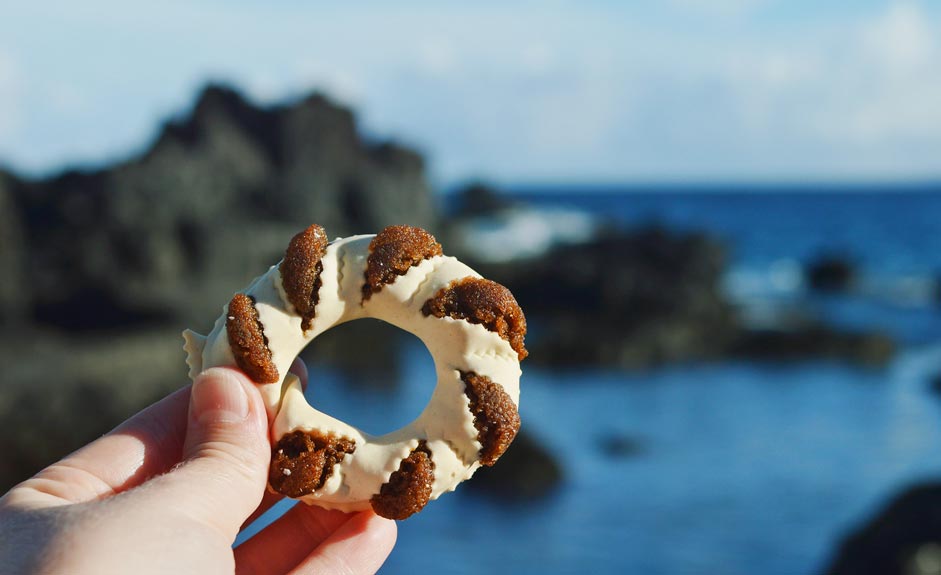
São Jorge is known for the traditional celebrations
For a sparsely populated island, São Jorge has many events. The island is named after Saint George, and the celebration dedicated to the saint is organized annually on April 23rd. During the event there are processions, music performances and exhibitions in the town of Velas.
The Festas do Espírito Santo celebrations dedicated to the Holy Ghost take place between May and September in different parts of the island. These important religious events gather people from all corners of the island and even internationally. Especially those who emigrated from São Jorge usually return to their home island during these celebrations.
In July, the Cultural Week of Velas (Semana Cultural das Velas) takes place bringing the sleepy village alive with musical shows, lectures, food market, conferences and a book fair. In Calheta, the Festival de Julho festivities take place in July, bringing traditional parades, popular music, sports events and exhibitions to the streets.
Other events on the island include the Carnival in February, Festa de Santa Ana, Festa do Emigrante and Festa dos Rosais. In the celebrations of São Jorge, the religious traditions are mixed up with the secular, for example when the viola da terra guitar starts accompanying the folk songs, or when the stand up comedians step on the stage. Bull fights can also take place during the festivities.
Shopping
São Jorge is not the best destination for shoppers, because the liveliest commercial spot is the quiet village of Velas. However, there are a handful of small boutiques where to make some unique finds, and also some supermarkets. The small municipal marketplace of Velas is located at Casa Cunha da Silveira and the local producers come to sell their products on Saturdays, twice a month. Besides Velas, there are some larger grocery stores also in Calheta.
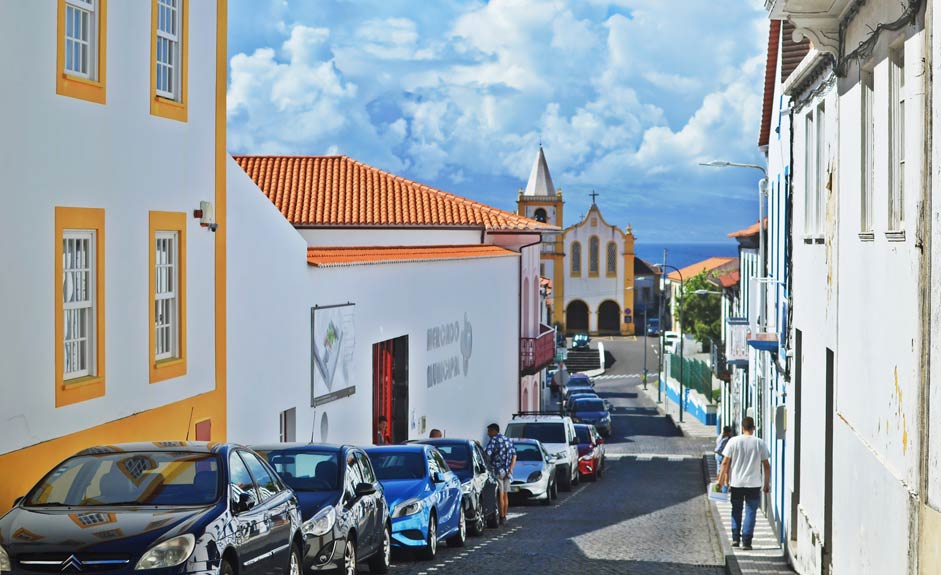
The best souvenirs from São Jorge include cheeses and conserved foods produced on the island, such as jams and canned fish products. The locally made handicrafts are also an excellent souvenir choice.
How to get to São Jorge and moving around the island
There is neither an international airport nor direct flights for example from Lisbon to São Jorge, so the journey includes a layover at another Azorean island, either on Terceira or on São Miguel. The operating airlines include Azorean Airlines (SATA) and the national aeration company TAP Portugal. Oftentimes, getting to São Jorge takes two or more layovers.
São Jorge, Pico and Faial form a triangle of islands and are connected by ferries all year round. It’s easy to include these three islands in the same vacation when time allows. During the summer months (from May to October) the Atlânticoline ferries also operate to other Azorean islands.
There are only a few rare bus routes driving between the villages of São Jorge, so renting a car is basically a must. The rates start from 20-35 euros per day. There are car rental agencies on the São Jorge airport as well as in the center of Velas.
Some of the fajã villages on the coast of São Jorge are not accessible by car, but only by foot or an ATV. The car roads that do allow driving into the villages are steep and narrow switchback roads, so driving on São Jorge requires good breaks and nerves.
Many hiking routes of São Jorge are linear, meaning that they end in a different place than they started from, so there might be a need for taxi despite renting a car. The taxi companies also organize tours on the island.
The airport of São Jorge is located in Queimada, between Velas and Urzelina, so a taxi ride to the hotel or car agency located in the center of the Velas town is cheap. The bus number 2 (Topo – Calheta – Velas (SUL)) operates next to the airport once per day towards each direction.
Weather and climate on São Jorge
Much alike the other Azorean islands, São Jorge has a subtropical, mild and humid climate, making the island a year-round travel destination. However, the weather changes rapidly, which is why in the Azores it’s possible to experience all four seasons in one day, be it summer or winter. The holiday plans are best executed by looking at the weather forecast first. A clear day is perfect for visiting the viewpoints and mountains, while visibility is good. Oftentimes it’s sunny on the coast, even though the center part of the island would be covered with clouds.
The sea temperatures remain comfortable for swimming, thanks to the Gulf Stream passing close by the Azores. The sea water temperatures are 16 °C in the winter and approximately 24 °C in the summer.

Winter: The daytime winter temperatures range between 15 and 17 °C and nighttime from 11 to 14 °C. The winters are rainy and storms are frequent, bringing them high winds and high waves. São Jorge receives the most rain between October and December.
Spring: The oceanic climate causes a delayed arrival of spring, and in springtime the air warms up slowly. Only in May there is a clear difference to winter, even though there are some warmer days already in April.
Summer: The daytime temperatures stay between 22 and 25 °C in July – September, whereas the nighttime temperatures range from 18 to 20 °C. The humidity of over 73% year round makes the heat feel more extreme. São Jorge receives the least rains from June until August, but rains are also relatively rare in May and September.
Autumn: September is temperature-wise a summer month, being on average warmer than June. The temperatures start to drop and rains begin in October. During autumns, there are tropical storms and even hurricanes passing by the archipelago, but they are usually already decreased in power when reaching the Azores. Also the location of São Jorge between the other islands protects it from the worst weather.
---
Text and photos: Johanna Maldonado



